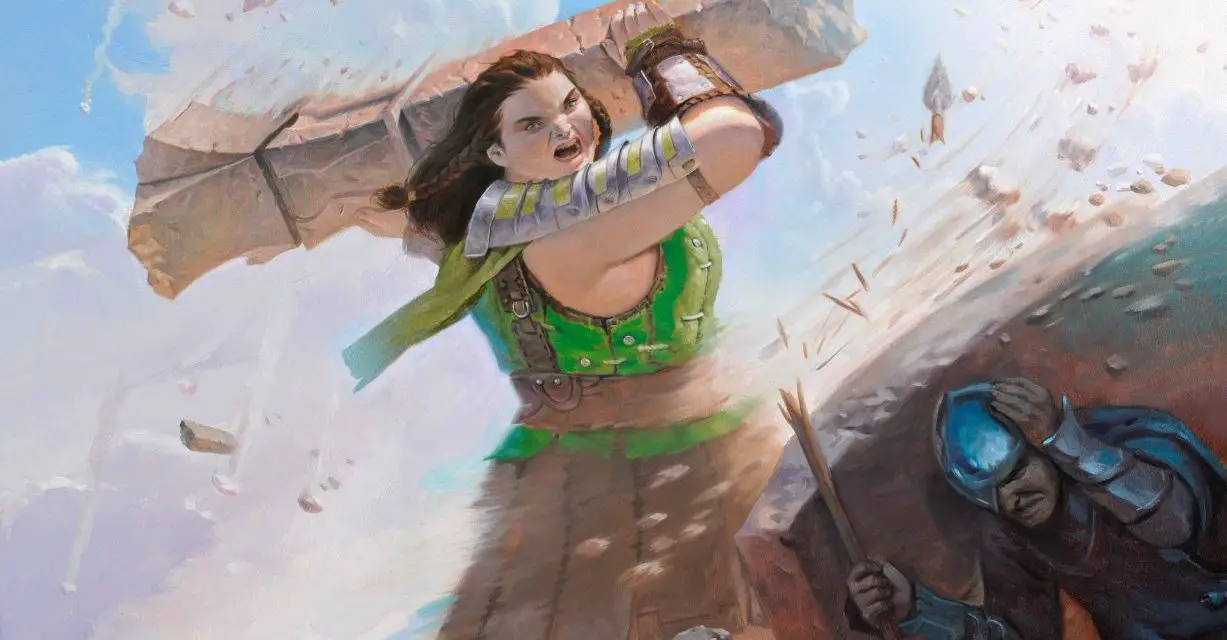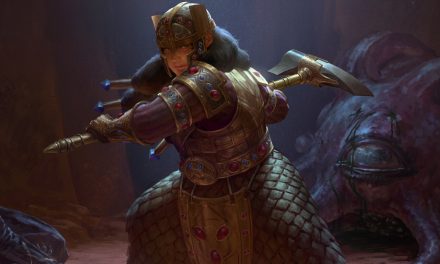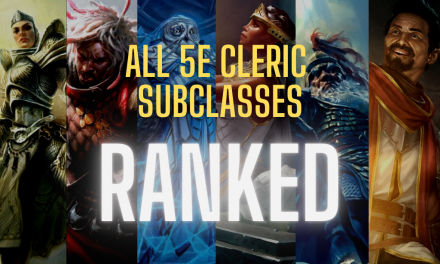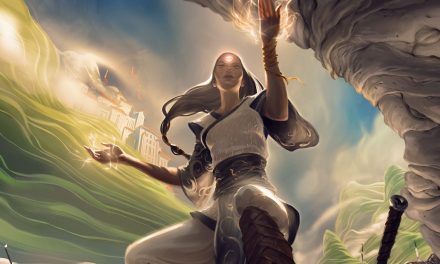When it comes to raw physical might, the Path of the Giant Barbarian in D&D 5e has learned from the masters.
With the ability to change their size and harness elemental power, these warriors are a sight to behold! With this subclass’s special focus on throwing weapons, enemies can try to run, but they won’t get far.
In this article, we’re diving into the details of this fantastic subclass. With towering size, terrifying strength, and plenty of anger issues, the Giant Barbarian is one you don’t want to miss.
So, let’s get right to it!
This is the full subclass guide to the Path of the Giant Barbarian in D&D 5e!
What is the Path of the Giant Barbarian in D&D 5e?
Barbarians who take the Path of the Giant have learned how to tap into an ancient, primal power. Much like the Giants that also embody this power, Giant Barbarians develop a deep affinity with certain elements.
As with most Barbarian subclasses, the features you gain with this subclass are used to expand what you’re capable of while raging.
Spoiler alert: you’re not exactly what we’d call a “gentle giant.”
Giving in to a giant-fueled rage, these Barbarians grow in size and become particularly dangerous with thrown weapons.
In fact, yeeting weapons (and even other creatures!) is the core of how this subclass works. Add in some terrifying elemental powers and you’ve got a one-person storm capable of leveling virtually any foe!
How’s that for a temper tantrum, eh?
The Path of the Giant Barbarian appears in the Bigby Presents: Glory of the Giants supplement for D&D 5e.
Role in the Party
The Path of the Giant Barbarian has a unique role in the party that makes it stand out from most other Barbarians.
Your typical Barbarian focuses on getting to the party’s front line, raging, and acting as a meat shield for the rest of the party while putting out as much damage as possible.
The Path of the Giant Barbarian is certainly just as capable of that.
However, most of the features that they gain are based around throwing weapons, which means that Giant Barbarians actually want some distance between them and their enemy.
If you’re on the party’s frontlines, you’ll be able to reach enemies further back. This is great for picking off ranged enemies (like archers or spellcasters) as well as those who are trying to run away.
However, ranged attacks don’t really work as well when you’re trying to attack someone who is directly in front of you.
You’ll have plenty of opportunities to use your features if there is some distance between you and your enemies. However, you don’t want to be too far back.
The Giant Barbarian still focuses on putting out a lot of damage, but this subclass particularly rewards positioning. Considering your ability to change your size, positioning and taking up space is a vital part of your role!
The middle of your party’s formation is an ideal place for a Giant Barbarian.
There, they have plenty of opportunities to use their thrown weapons while also being able to serve as an extra line of defense for the squishier backline party members.
But when it’s time to move forward, the Giant Barbarian serves as a type of defensive artillery. They can draw a line in the sand and make sure that that line doesn’t get pushed back.
Enemies that get too close can either be dealt with “the old-fashioned way” or promptly thrown elsewhere.
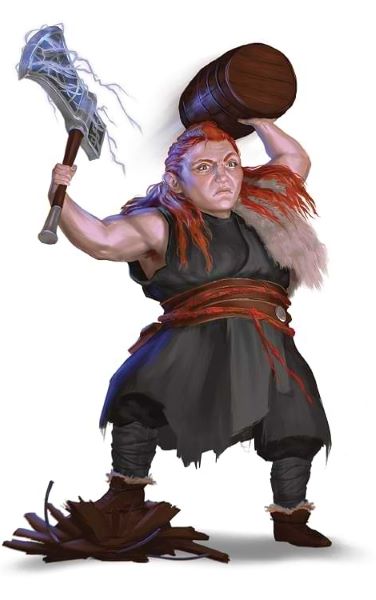
Path of the Giant Barbarian Features 5e
Now that we’ve gone over what the Path of the Giant Barbarian is and their role in the party, let’s take a closer look at the features they gain as they level up.
For the most part, these features build on each other in a way that feels natural and rewarding.
There’s certainly some immediate value with this subclass’s earliest features, but it’s how they build on top of each other that gets really exciting.
Let’s dive in!
Related: Barbarian Rage in D&D 5e Explained
Giant’s Power (Level 3)
We start things off with a ribbon feature. It’s nothing amazing, but potentially nice to have in certain situations.
You learn to speak, read, and write Giant or one other language of your choice if you already know Giant.
Additionally, you learn a cantrip of your choice: either Druidcraft or Thaumaturgy. Wisdom is your spellcasting ability for this spell.
Being able to speak Giant could potentially be helpful, depending on what kind of campaign you’re playing.
Both Druidcraft and Thaumaturgy can be fun and used in creative ways, but they’re nothing huge. Still, they could offer a bit of creative utility.
But don’t worry! Your other level 3 feature brings a lot to the table!
Giant’s Havoc (Level 3)
Your first “real” feature is Giant’s Havoc, which gives you new benefits while raging!
While raging, you gain the following benefits:
Crushing Throw: When you make a successful ranged attack with a thrown weapon using Strength, you can add your Rage Damage bonus to the attack’s damage roll.
Giant Stature: Your reach increases by 5 feet, and if you are smaller than Large, you become Large, along with anything that you are wearing. If there isn’t enough room for you to increase your size, your size doesn’t change.
With Crushing Throw, you’re adding the bonus damage from your Rage to attacks you make with thrown weapons.
Of course, this damage will increase as you level up. It’s a handy perk to have and sets the stage for what lies ahead!
But the major draw to the Giant’s Havoc feature is the Giant Stature benefit.
An extra 5 feet of reach is simply fantastic. Furthermore, take note that you’re gaining this extra reach whether you increase your size or not.
So maybe you’re in a cramped dungeon that isn’t really ideal for growing by a whole size category. You’ll still have a much easier time smacking enemies who think they’re out of your reach!
Somewhat comedically, if you’re using a polearm (like a halberd or glaive that has the “Reach” property), you’ll be smacking enemies that are up to a whopping 15 feet away!
If you do decide to grow in size, pay attention to your positioning. You want to use your size to take up space and prevent enemies from moving forward or retreating.
How’s that for throwing your weight around?!
Recommended: Throwing Weapons in D&D 5e Explained
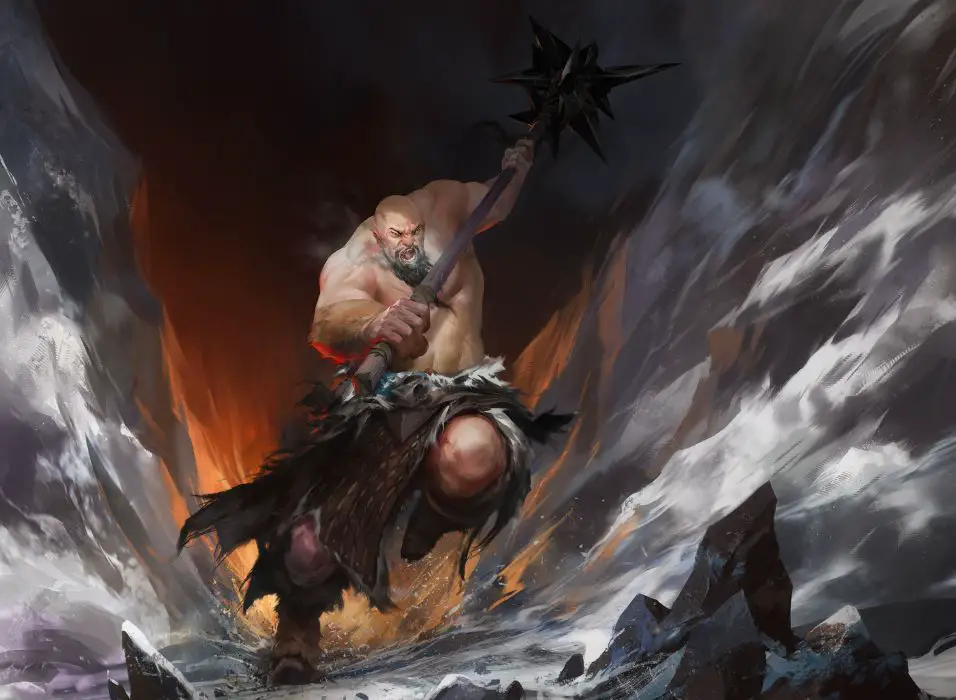
Elemental Cleaver (Level 6)
Level 6 is when the Path of the Giant Barbarian really comes online thanks to the Elemental Cleaver feature.
Not only are you going to be dealing even more damage, but it just became much easier to focus on throwing weapons.
And as it happens, nearly anything can be a throwing weapon when you’re a raging Giant Barbarian!
When you enter your rage, you can choose one weapon that you are holding and infuse it with one of the following damage types: acid, cold, fire, thunder, or lightning.
While you wield the infused weapon during your rage, the weapon’s damage type changes to the chosen type, it deals an extra 1d6 damage of the chosen type when it hits, and it gains the thrown weapon property, with a normal range of 20 feet and a long range of 60 feet.
If you throw the weapon, it reappears in your hand the instant after it hits or misses a target. The infused weapon’s benefits are suppressed while a creature other than you wields it.
While raging and holding the infused weapon, you can use a bonus action to change the infused weapon’s current damage type to another one from the damage type options above.
First things first, you’re picking one of five damage types to infuse your weapon with.
Obviously, you want to pick a damage type that can exploit an enemy’s weakness. If they aren’t weak to a specific damage type, at least choose one that they aren’t resistant or immune to!
If you need to swap the damage type mid-combat, you can do so for the low cost of a bonus action.
But as nice as the extra damage and elemental infusion is, that’s not the biggest part of this feature…
Notice that whatever weapon you infuse is gaining the thrown property. Who knew that yeeting a glaive could be so effective?
But let’s not stop there!
The days of throwing weapons at enemies only to realize that you’ve disarmed yourself are long gone. Furthermore, so is the awkward post-combat clean-up where you had to gather everything you just threw at your foes to prepare for the next fight.
When you throw your infused weapon, it instantly reappears in your hand whether you hit or miss.
So, if you acquired an epic weapon but are worried about accidentally losing it, you have nothing to fear. Whether in melee or ranged combat, you’ll always be ready to lay the smackdown!
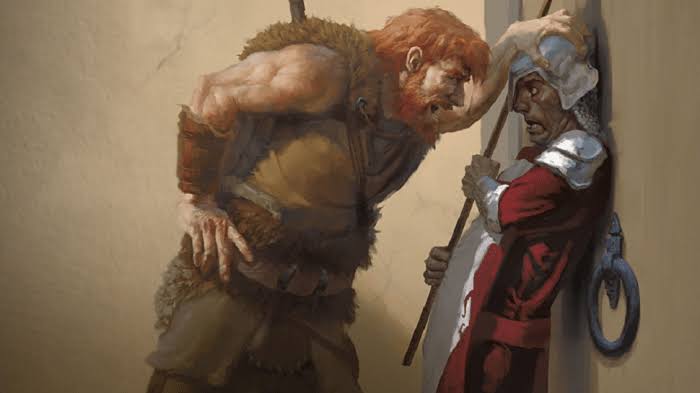
Mighty Impel (Level 10)
At level 10, the Path of the Giant Barbarian is able to start giving flying lessons.
Though I suppose how those lessons go depends on whether we’re talking about a friend or foe…
As a bonus action while raging, you can choose one Medium or smaller creature within your reach and move it to an unoccupied space you can see within 30 feet of yourself.
An unwilling creature must succeed on a Strength saving throw (DC equal 8 + your proficiency bonus + your Strength modifier) to avoid the effect.
If, at the end of this movement, the thrown creature isn’t on a surface or liquid that can support it, the creature falls, taking damage as normal and landing prone.
For allies, there’s an obvious utility here.
You can easily help your friends reach vantage points, escape an enemy, or clear certain obstacles and hazards.
Perhaps a flying enemy is getting cocky until you decide to throw the Paladin up to them to deliver a truly surprising Divine Smite in mid-air!
But you can also severely ruin enemies’ days with this as well.
If you’re trying to throw an enemy, they will get a chance to make a Strength saving throw. However, you’ve likely invested heavily in your Strength score, which will make it tougher for them to resist.
You might throw the enemy into an environmental hazard (like lava or a whirlpool) or into an AoE spell effect like Cloudkill or something.
Of course, you might also just chuck them off a ledge or, if nothing else, straight up into the air. Now they have to deal with some nasty falling damage and are left prone on the ground for some wicked follow-up attacks at advantage!
The best part: this only takes a bonus action.
Recommended: Full Guide to the Barbarian’s Reckless Attack
Demiurgic Colossus (Level 14)
Finally, the Path of the Giant Barbarian’s capstone feature takes what we already love about our previously-gained features and dials them up further.
This is exactly the type of capstone that I like to see: short, sweet, simple, and effective!
When you rage, your reach increases by 10 feet, your size can increase to Large or Huge (your choice), and you can use your Mighty Impel to move creatures that are Large or smaller.
Additionally, the extra damage dealt by your Elemental Cleaver feature increases to 2d6.
As with Giant Stature in your Giant’s Havoc feature, you gain the extra reach whether you change size or not. Instead of 5 feet of extra reach, you’re getting 10 feet which is honestly kind of insane.
Additionally, you can now become Huge size if you so desire. You should have no problem taking and making space now!
And because you can throw creatures that are up to Large in size, you’ll be able to throw all but the biggest of foes with relative ease.
Last but not least, your damage from Elemental Cleaver gets a nice bump to 2d6 extra damage.
Don’t underestimate how much damage this is! 2d6 extra damage plus your Rage damage on each attack will add up VERY fast!
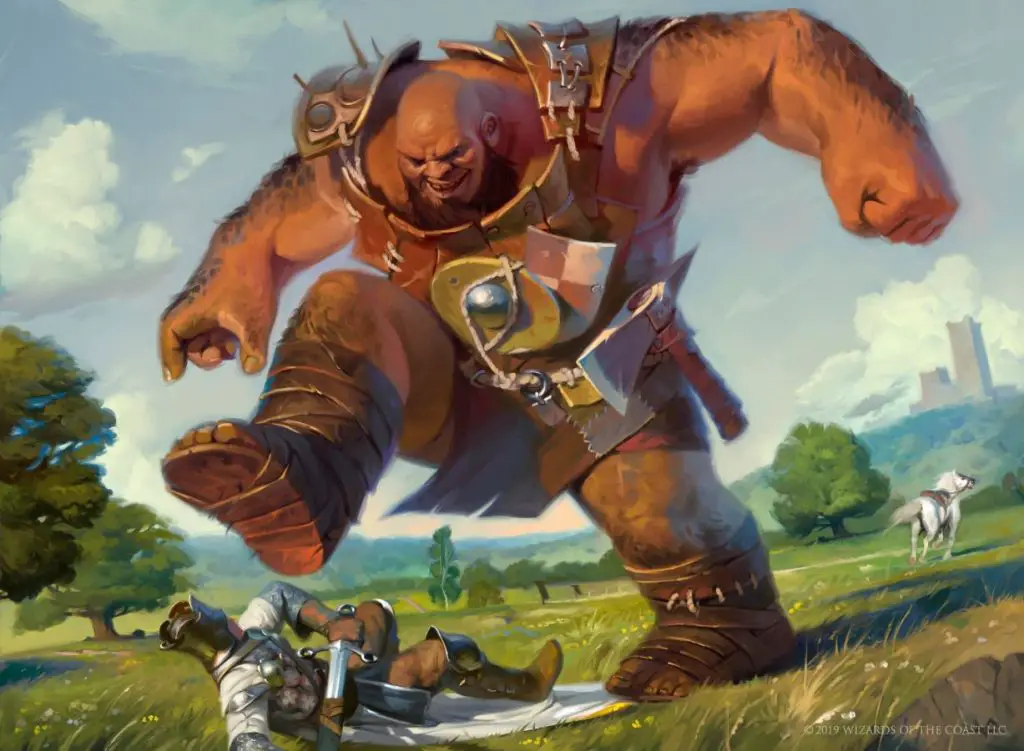
Connections
Needless to say, Path of the Giant Barbarians are right at home in campaigns that feature Giants.
Perhaps your character comes from a place near a settlement of Giants and has learned how to use those same powers and techniques for themselves.
In the case of something like Stone Giants, they might have learned these techniques on friendlier terms.
However, they might have instead been inspired to give marauding Frost Giants or tyrannical Fire Giants a taste of their own medicine!
There’s also some really fun potential to intertwine a Path of the Giant Barbarian’s story with that of an ally who is playing as a Rune Knight Fighter.
Where a Rune Knight Fighter focuses more on the technique and mystical runes aspects of Giant culture, the Giant Barbarian goes all-in on raw, primal strength.
Is the Path of the Giant Barbarian Good?
I was originally a little apprehensive about the Path of the Giant Barbarian, but it really surprised me.
This is definitely a very different type of Barbarian. Staying keenly aware of your positioning and how to both take and make space on the battlefield is the key to staying effective with this subclass.
Thankfully, that is made very easy by your ability to change your size!
The early levels of this subclass are decent, but it’s at level 6 when it really starts to shine. While there is a lot to love about the Elemental Cleaver feature, its greatest benefit is having your thrown weapon immediately return to your hand.
I do find it a little funny that the range of the Giant Barbarian’s thrown weapons doesn’t increase as they level up, but that’s a very minor gripe. A long range of 60 feet isn’t bad, and the disadvantage is very easily overcome by simply using Reckless Attack.
Though I think Mighty Impel might just be my personal feature here.
Entering a rage and going full Incredible Hulk while throwing enemies and objects around the battlefield makes for some very fun descriptions in combat!
All in all, the Path of the Giant Barbarian brings a fun, new approach to playing a Barbarian and is absolutely worth a try.
Related: Ranking Every Barbarian Subclass in D&D 5e!
Conclusion – Path of the Giant Barbarian in D&D 5e
I hope you’ve found this guide to the Path of the Giant Barbarian in D&D 5e helpful!
More than any class in D&D 5e, it seems like Barbarians get a certain reputation as being “pretty much all the same.”
While I disagree with that take, I do get where it comes from. Fortunately, the Giant Barbarian really brings something new and exciting to the table.
Furthermore, it’s about time we’ve gotten a Barbarian that can also operate well at range!
Got a character concept you’d like to share or questions about this subclass? Let’s chat in the comments!
Want all the latest player guides, DM tips, news, reviews, and more for D&D 5e? Sign up for the Tabletop Joab newsletter below!
You can also follow me on Facebook and Twitter!
If you found this article helpful and want to support the site, you can buy me a coffee here! (It’s not expected, but very appreciated!)

